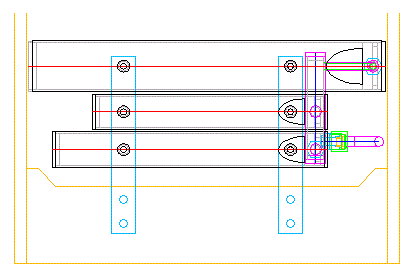< Whistle >
There is little space for the whistle in the three-cylinder C53's chassis. I barely secured space between the trailing frames. There is no longitudinal clearance, so the whistle should be set sideways. It means that the whistle length must be less than the trailing frame's inner width. Regarding the musical pitch, I found that some British full-size locos' whistles have relatively higher pitches than those of Japanese locos, and are easy to reproduce for model locos. I checked several prototypes and chose the LNER A4's three-chime whistle. The chord is C-F-Ab and the lowest note C requires a 160 mm air column, while the inner distance of the trailing frames is 180 mm. As a whistle requires additional length for both plugs and an open window, the clearance is marginal. Therefore I designed the lowest-tone whistle to cover the whole width of the trailing frames. Alternatively, the other two whistles' lengths are determined by the tone intervals of the chord.

The whistle-designing process had been introduced in the article about William's whistle-making. The whistle pipes' diameters are 25.4 mm for the lowest whistle, and 18 mm for the other two whistles. The pipes' thickness is all 1 mm.
The windows' shape is half of an ellipse. Stick printed ellipses on the brass pipes and scribe the window shape on the pipes with a cutter knife.
Open the window with a series of drill holes. Finish the window with fine files.
The photo shows the plugs to close both ends of the whistle pipe. The plug in the window's side has room for steam and has a gap for the steamway.
The curved gap is milled in a jig on the rotary table. The gap has to be adjusted by actually blowing the whistle. I started from a 0.5 mm gap.
A manifold to supply steam to the three whistles is made from copper and brass parts.
Silver solder a nipple for the steam inlet and two studs for fixing screws.
The assembled whistle set. The plugs are not soldered but press-fitted to the pipes in order to adjust the gaps and the length of the pipes later.
The whistle assy placed in the trailing frames. It is screwed under the roof plate of the rear buffer block. The whole body of the whistle assy is hidden between the trailing frames.
The air-blowing test was done with 0.3 MPa compressed air. The pitch is a little lower than A4 but the harmony is the same. As the voice had slightly cracked, I increased the gaps. Finally, the gaps are 1.0 mm for the lowest whistle, and 0.8 mm for the other two whistles.
The whistle and the whistle valve were connected to the Hunslet's steam dome and tested with 0.4 MPa steam. The pitch became higher than that with air because the steam temperature is higher.
Here is the actual sound of the whistle with air and steam. The difference in pitch is obvious.